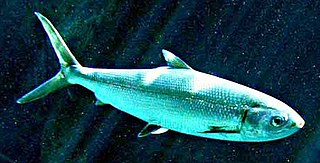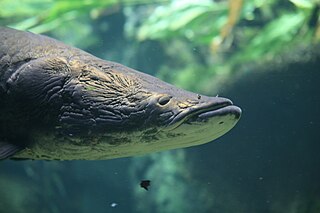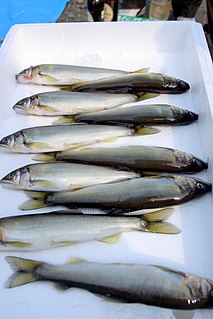 W
WAcanthopterygii is a superorder of bony fishes in the class Actinopterygii. Members of this superorder are sometimes called ray-finned fishes for the characteristic sharp, bony rays in their fins; however this name is often given to the class Actinopterygii as a whole.
 W
WBatoidea is a superorder of cartilaginous fishes commonly known as rays. They and their close relatives, the sharks, comprise the subclass Elasmobranchii. Rays are the largest group of cartilaginous fishes, with well over 600 species in 26 families. Rays are distinguished by their flattened bodies, enlarged pectoral fins that are fused to the head, and gill slits that are placed on their ventral surfaces.
 W
WClupeiformes is the order of ray-finned fish that includes the herring family, Clupeidae, and the anchovy family, Engraulidae. The group includes many of the most important forage and food fish.
 W
WThe superorder Elopomorpha contains a variety of types of fishes that range from typical silvery-colored species, such as the tarpons and ladyfishes of the Elopiformes and the bonefishes of the Albuliformes, to the long and slender, smooth-bodied eels of the Anguilliformes. The one characteristic uniting this group of fishes is they all have leptocephalus larvae, which are unique to the Elopomorpha. No other fishes have this type of larvae.
 W
WThe Neoteleostei is a large clade of bony fish that includes the Ateleopodidae (jellynoses), Aulopiformes (lizardfish), Myctophiformes (lanternfish), Polymixiiformes (beardfish), Percopsiformes (Troutperches), Gadiformes (cods), Zeiformes (dories), Lampriformes, and the populous clade of the Acanthopterygii which includes the Beryciformes (squirrelfish) and the Percomorpha.
 W
WOstariophysi is the second-largest superorder of fish. Members of this superorder are called ostariophysians. This diverse group contains 10,758 species, about 28% of known fish species in the world and 68% of freshwater species, and are present on all continents except Antarctica. They have a number of common characteristics such as an alarm substance and a Weberian apparatus. Members of this group include fish important to people for food, sport, the aquarium industry, and research.
 W
WThe Osteoglossomorpha are a group of bony fish in the Teleostei.
 W
WOsteolepidida, also known as osteolepiformes, are a group of prehistoric lobe-finned fishes which appeared first time during the Devonian period. The order contains five families: Canowindridae, Megalichthyidae, Osteolepidae, Thysanolepidae and Tristichopteridae. The superorder is generally considered to be paraphyletic because the characters that define it are mainly attributes of stem tetrapodomorphs.
 W
WParacanthopterygii is a superorder of fishes. Members of this group are called paracanthopterygians.
 W
WThe beardfishes consist of a single extant genus, Polymixia, of deep-sea marine ray-finned fish named for their pair of long hyoid barbels. Until recently they were classified in their own order Polymixiiformes. But as Nelson says, "few groups have been shifted back and forth as frequently as this one, and they were recently added to Paracanthoptergii". For instance, they have previously been classified as belonging to the Beryciformes. They are of little economic importance.
 W
WProtacanthopterygii is a ray-finned fish taxon ranked as a superorder of the infraclass Teleostei. They inhabit both marine and freshwater habitats. They appear to have evolved in the Cretaceous or perhaps late Jurassic, originating probably roughly 150 million years ago; fossils of them and the closely related Otocephala are known from throughout the Cretaceous.
 W
WThe Myctophiformes are an order of ray-finned fishes consisting of two families of deep-sea marine fish, most notably the highly abundant lanternfishes (Myctophidae). The blackchins (Neoscopelidae) contain six species in three genera, while the bulk of the family belongs to the Myctophidae, with over 30 genera and some 252 species.
 W
WSharks are a group of elasmobranch fish characterized by a cartilaginous skeleton, five to seven gill slits on the sides of the head, and pectoral fins that are not fused to the head. Modern sharks are classified within the clade Selachimorpha and are the sister group to the rays. However, the term "shark" has also been used for extinct members of the subclass Elasmobranchii outside the Selachimorpha, such as Cladoselache and Xenacanthus, as well as other Chondrichthyes such as the holocephalid eugenedontidans.